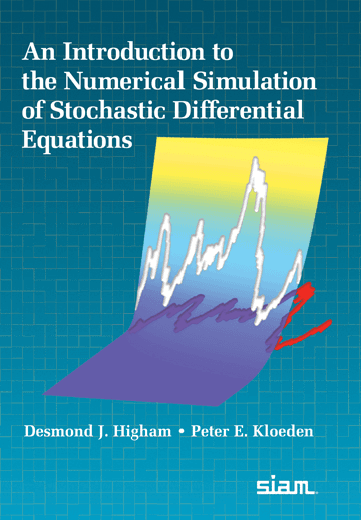All rights reserved.
The aim of the book under review is to “provide a lively, accessible introduction to the numerical solution of stochastic differential equations (SDEs)” (taken from the first sentence of the preface). Knowing the scientific expertise of the two authors of this book as well as their communication skills, it was clear to me from the start that this aim would be reached. I hope that my review will illustrate this fact.
SDEs and their numerical simulations are indispensable tools in a multitude of disciplines. They have been used in various application areas such as chemical kinetics, engineering, epidemic modeling, financial mathematics, neuroscience, physics, social sciences, etc. To understand these models and simulate solutions to SDEs efficiently requires advanced knowledge in probability theory, stochastic analysis, as well as numerical analysis. However, to understand the main ideas and concepts of SDEs and their numerical simulations using this book, it is enough to start with a good knowledge of algebra, calculus and some familiarity with numerical analysis and probability theory.
By reading this book (and doing the exercises!), the reader will develop an intuitive feeling for the main ideas around SDEs, learn to implement first numerical methods to efficiently simulate SDEs in various applications, and get ideas of the proofs of some of the fundamental theorems in numerics for SDEs. All this is accomplished thanks to a constant focus on the essential (avoiding technicalities), an engaging and pedagogical way of presenting the necessary material, and appropriate use of well-chosen (computational) examples and inviting (theoretical and computational) exercises.
The book under review is not a rigorous text in mathematics, and the authors acknowledge this in many places. The interested reader is often referred to the more advanced and technical literature on the subject. For more rigorous and advanced books on the numerical treatment of SDEs, one could consult for instance: Numerical Solution of Stochastic Differential Equations by Kloeden, Platen, or Stochastic Numerics for Mathematical Physics by Milstein, Tretyakov, or Numerical solution of SDE through computer experiments by Kloeden, Platen, Schurz.
The present book contains 20 chapters, ordered in a very didactic manner in increasing order of difficulty (at least according to me). Each chapter starts with a compact outline in bullet points, a small picture reflecting the content of the chapter, and a clear and concise statement of motivation, and each one is illustrated with several accessible (computational) examples. Every chapter ends with notes and references (e.g. for further advanced reading), a list of both theoretical and computational exercises (with solutions available at the publisher’s website), and most importantly, some funny quotes! At the end, the book provides a list of symbols, an index and an extensive bibliography.
Let me now give a brief description of the content of each chapter. The first chapter presents (discrete and continuous) random variables and related topics. Chapter 2 introduces basic computational concepts to simulate random variables. The third chapter contains the heart of the theory of SDEs, namely Brownian motion and its main properties. Chapter 4 deals with (mostly Itô) stochastic integrals. These four chapters provide all the tools required to define scalar SDEs, which are duly presented in Chapter 5, along with many examples from the domains of application. One particularly important tool, namely the Itô formula, is described in Chapter 6. The goal of Chapter 7 is to give a brief overview of the Stratonovich form of an SDE. Chapter 8 deals with the simplest and most used numerical scheme for SDEs: the Euler–Maruyama scheme. Chapters 9 and 10 give a sketch of the proofs of weak and strong convergence of the Euler–Maruyama scheme. From this point on, my impression is that the chapters begin touching on more advanced topics. Chapter 11 investigates the mean-square and asymptotic stability of the stochastic -method. The aim of Chapter 12 is to use numerical methods in a Monte Carlo setting to compute mean exit times in several applications. Chapter 13 deals with a typical area of application of SDEs: computing various financial quantities. Chapter 14 investigates long-time properties of SDEs and steady states. Chapter 15 presents the multilevel Monte Carlo technique to reduce the computational cost of the classical Monte Carlo method. Chapter 16 introduces SDEs with jumps. Chapter 17 presents a derivation of high-order numerical methods for SDEs (based on stochastic Taylor expansions). Chapters 18 and 19 extend the main concepts seen so far to systems of SDEs. Finally, the last chapter of the book deals with stochastic modeling and simulation of chemical reactions.
The book under review is very well written, accessible, enjoyable to read, not too long, and offers heuristic explanations to key concepts and results on SDEs and their numerical discretisations. It is an ideal book for undergraduate and graduate students in mathematics and statistics, as well as interested students from computer science, engineering, finance, life sciences, or physics, for instance. This book is also recommended for more “senior” scientists who would like to learn the “basics” about numerics for SDEs, for example to give an introductory lecture on the subject.
Desmond J. Higham and Peter E. Kloeden, An Introduction to the Numerical Simulation of Stochastic Differential Equations. SIAM, 2012, 293 pages, Hardback ISBN 978-1-6119-7642-7
Cite this article
David Cohen, Book Review: “An Introduction to the Numerical Simulation of Stochastic Differential Equations” by Desmond J. Higham and Peter E. Kloeden. Eur. Math. Soc. Mag. 122 (2021), pp. 68–69
DOI 10.4171/MAG/51
